The Role of Hospitality in Tourism: Marina Bay Sands Case Study
VerifiedAdded on 2023/04/25
|32
|5135
|247
Report
AI Summary
This report examines the significance of the hospitality industry in sustainable tourism development, using Marina Bay Sands in Singapore as a case study. It explores the hotel's strategies for attracting international premium customers and analyzes the challenges it faces, such as high prices and a focus on premium clientele, which limits its customer base. The report reviews literature on sustainable tourism, the role of hotels, and factors affecting hospitality and tourism development. The methodology includes a research design, data collection, and analysis of demographic data and customer feedback. The findings highlight the importance of multilingualism and flexible communication to enhance customer satisfaction and expand the customer base. The study also identifies gaps in the literature and offers recommendations for improving the hotel's services and marketing strategies to achieve broader appeal and sustainable tourism practices. It concludes that while premium services are important, the hospitality business must cater to a diverse customer base to thrive.
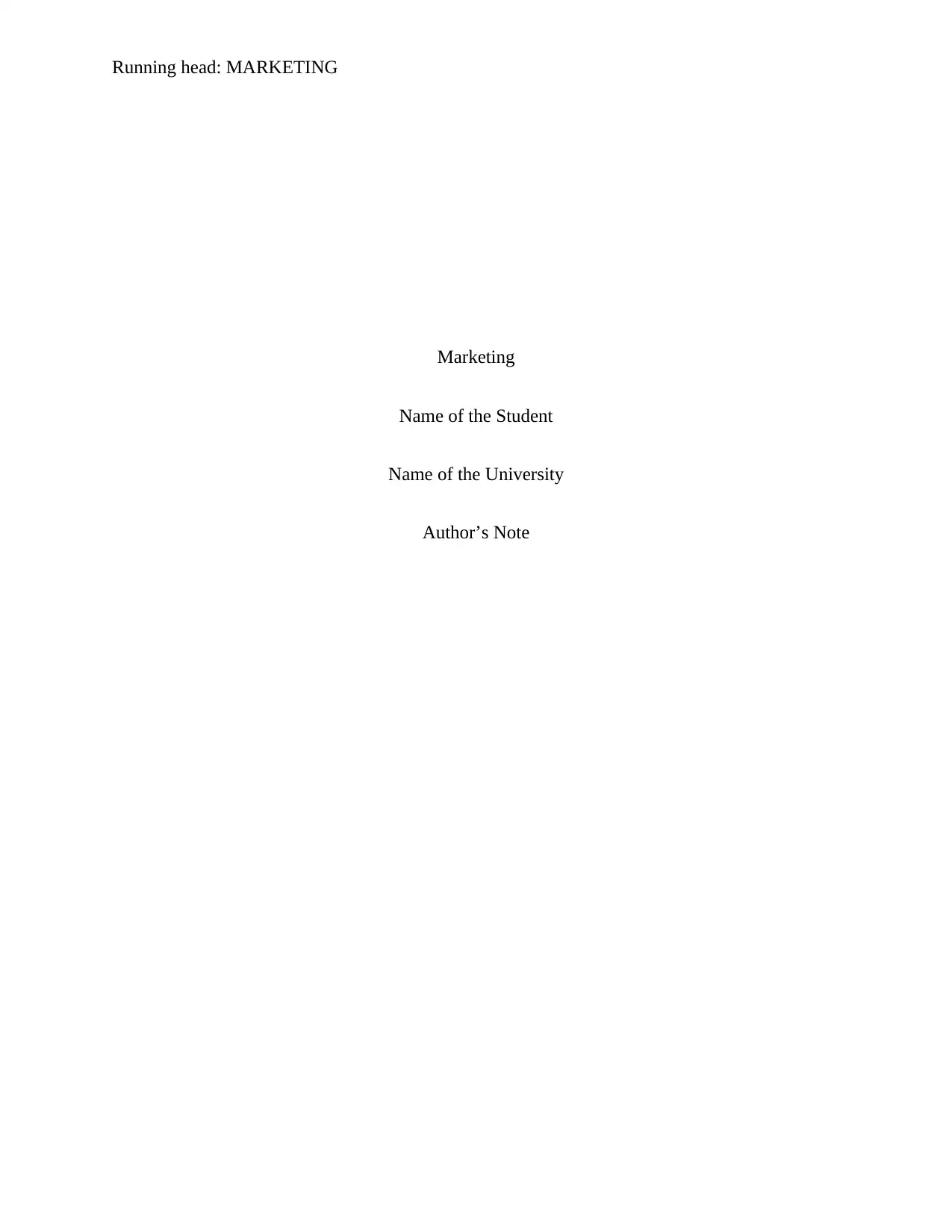
Running head: MARKETING
Marketing
Name of the Student
Name of the University
Author’s Note
Marketing
Name of the Student
Name of the University
Author’s Note
Paraphrase This Document
Need a fresh take? Get an instant paraphrase of this document with our AI Paraphraser
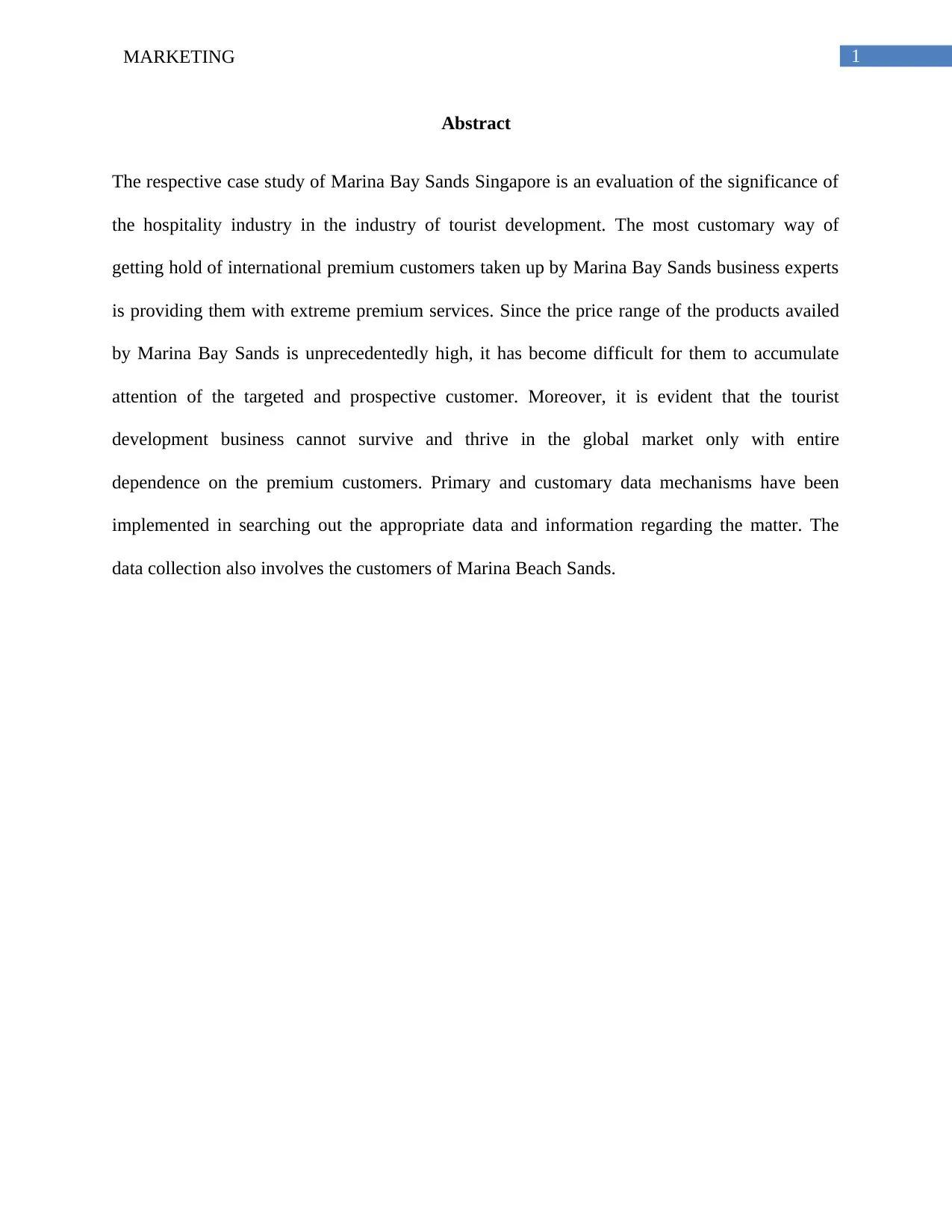
MARKETING 1
Abstract
The respective case study of Marina Bay Sands Singapore is an evaluation of the significance of
the hospitality industry in the industry of tourist development. The most customary way of
getting hold of international premium customers taken up by Marina Bay Sands business experts
is providing them with extreme premium services. Since the price range of the products availed
by Marina Bay Sands is unprecedentedly high, it has become difficult for them to accumulate
attention of the targeted and prospective customer. Moreover, it is evident that the tourist
development business cannot survive and thrive in the global market only with entire
dependence on the premium customers. Primary and customary data mechanisms have been
implemented in searching out the appropriate data and information regarding the matter. The
data collection also involves the customers of Marina Beach Sands.
Abstract
The respective case study of Marina Bay Sands Singapore is an evaluation of the significance of
the hospitality industry in the industry of tourist development. The most customary way of
getting hold of international premium customers taken up by Marina Bay Sands business experts
is providing them with extreme premium services. Since the price range of the products availed
by Marina Bay Sands is unprecedentedly high, it has become difficult for them to accumulate
attention of the targeted and prospective customer. Moreover, it is evident that the tourist
development business cannot survive and thrive in the global market only with entire
dependence on the premium customers. Primary and customary data mechanisms have been
implemented in searching out the appropriate data and information regarding the matter. The
data collection also involves the customers of Marina Beach Sands.
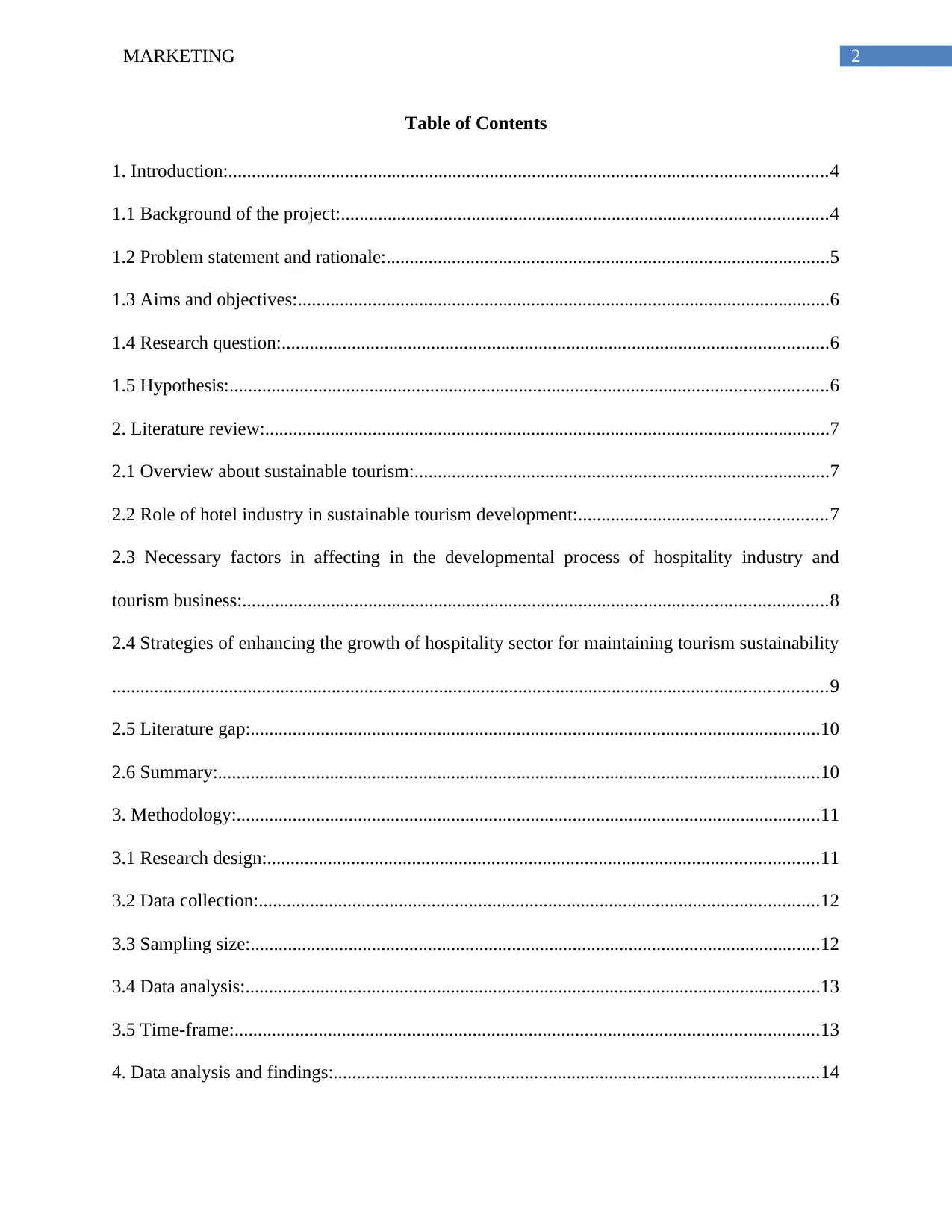
2MARKETING
Table of Contents
1. Introduction:................................................................................................................................4
1.1 Background of the project:........................................................................................................4
1.2 Problem statement and rationale:...............................................................................................5
1.3 Aims and objectives:..................................................................................................................6
1.4 Research question:.....................................................................................................................6
1.5 Hypothesis:................................................................................................................................6
2. Literature review:.........................................................................................................................7
2.1 Overview about sustainable tourism:.........................................................................................7
2.2 Role of hotel industry in sustainable tourism development:.....................................................7
2.3 Necessary factors in affecting in the developmental process of hospitality industry and
tourism business:.............................................................................................................................8
2.4 Strategies of enhancing the growth of hospitality sector for maintaining tourism sustainability
.........................................................................................................................................................9
2.5 Literature gap:..........................................................................................................................10
2.6 Summary:.................................................................................................................................10
3. Methodology:.............................................................................................................................11
3.1 Research design:......................................................................................................................11
3.2 Data collection:........................................................................................................................12
3.3 Sampling size:..........................................................................................................................12
3.4 Data analysis:...........................................................................................................................13
3.5 Time-frame:.............................................................................................................................13
4. Data analysis and findings:........................................................................................................14
Table of Contents
1. Introduction:................................................................................................................................4
1.1 Background of the project:........................................................................................................4
1.2 Problem statement and rationale:...............................................................................................5
1.3 Aims and objectives:..................................................................................................................6
1.4 Research question:.....................................................................................................................6
1.5 Hypothesis:................................................................................................................................6
2. Literature review:.........................................................................................................................7
2.1 Overview about sustainable tourism:.........................................................................................7
2.2 Role of hotel industry in sustainable tourism development:.....................................................7
2.3 Necessary factors in affecting in the developmental process of hospitality industry and
tourism business:.............................................................................................................................8
2.4 Strategies of enhancing the growth of hospitality sector for maintaining tourism sustainability
.........................................................................................................................................................9
2.5 Literature gap:..........................................................................................................................10
2.6 Summary:.................................................................................................................................10
3. Methodology:.............................................................................................................................11
3.1 Research design:......................................................................................................................11
3.2 Data collection:........................................................................................................................12
3.3 Sampling size:..........................................................................................................................12
3.4 Data analysis:...........................................................................................................................13
3.5 Time-frame:.............................................................................................................................13
4. Data analysis and findings:........................................................................................................14
⊘ This is a preview!⊘
Do you want full access?
Subscribe today to unlock all pages.

Trusted by 1+ million students worldwide
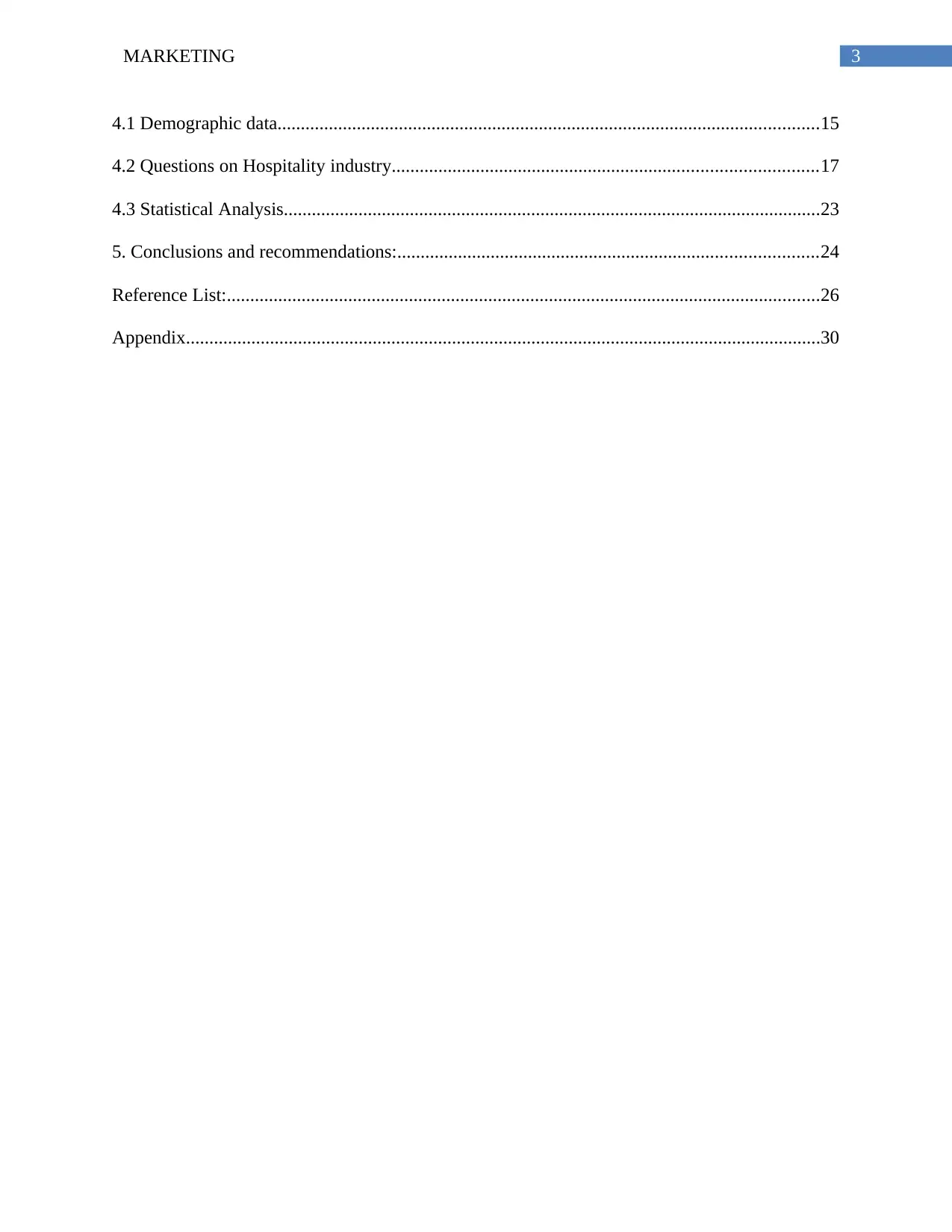
3MARKETING
4.1 Demographic data....................................................................................................................15
4.2 Questions on Hospitality industry...........................................................................................17
4.3 Statistical Analysis...................................................................................................................23
5. Conclusions and recommendations:..........................................................................................24
Reference List:...............................................................................................................................26
Appendix........................................................................................................................................30
4.1 Demographic data....................................................................................................................15
4.2 Questions on Hospitality industry...........................................................................................17
4.3 Statistical Analysis...................................................................................................................23
5. Conclusions and recommendations:..........................................................................................24
Reference List:...............................................................................................................................26
Appendix........................................................................................................................................30
Paraphrase This Document
Need a fresh take? Get an instant paraphrase of this document with our AI Paraphraser
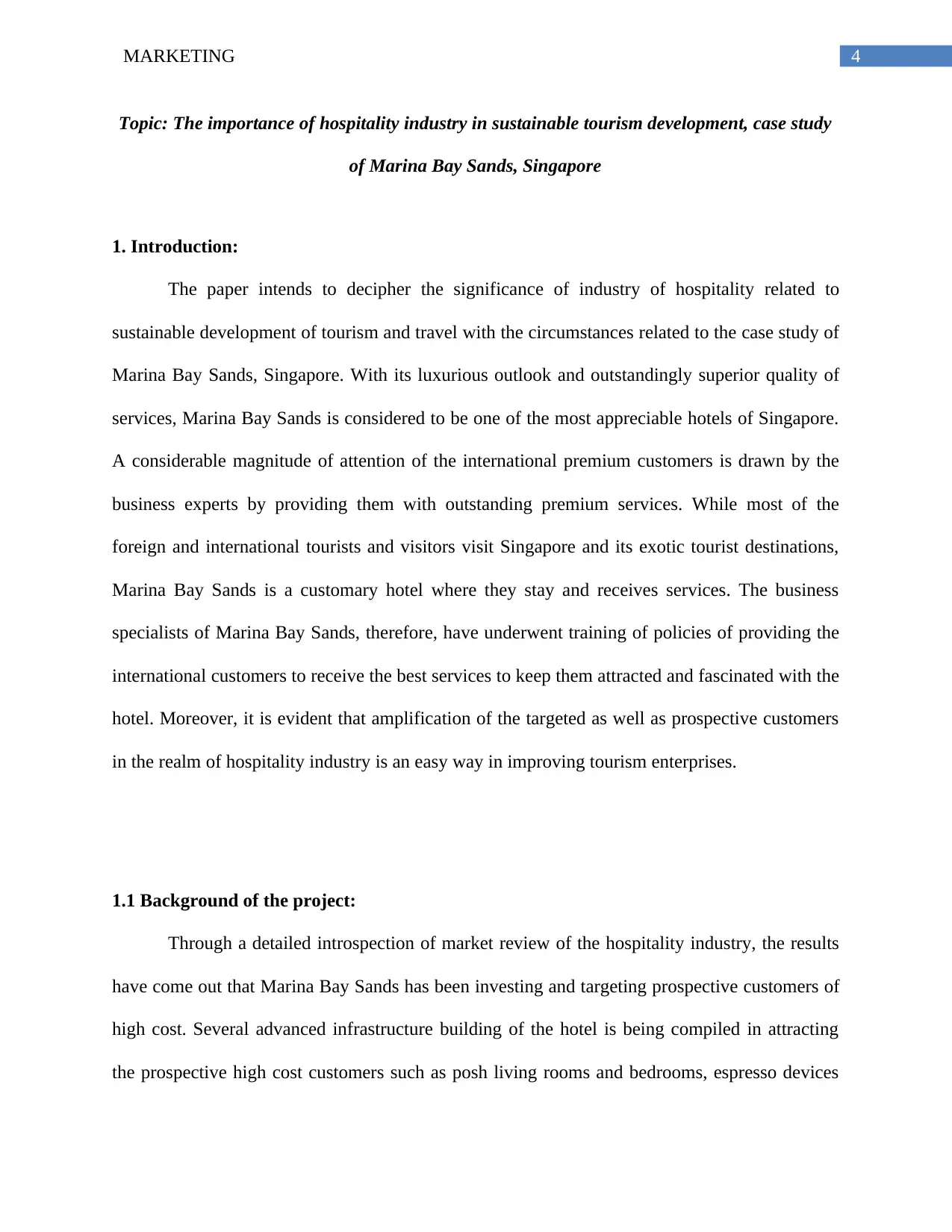
4MARKETING
Topic: The importance of hospitality industry in sustainable tourism development, case study
of Marina Bay Sands, Singapore
1. Introduction:
The paper intends to decipher the significance of industry of hospitality related to
sustainable development of tourism and travel with the circumstances related to the case study of
Marina Bay Sands, Singapore. With its luxurious outlook and outstandingly superior quality of
services, Marina Bay Sands is considered to be one of the most appreciable hotels of Singapore.
A considerable magnitude of attention of the international premium customers is drawn by the
business experts by providing them with outstanding premium services. While most of the
foreign and international tourists and visitors visit Singapore and its exotic tourist destinations,
Marina Bay Sands is a customary hotel where they stay and receives services. The business
specialists of Marina Bay Sands, therefore, have underwent training of policies of providing the
international customers to receive the best services to keep them attracted and fascinated with the
hotel. Moreover, it is evident that amplification of the targeted as well as prospective customers
in the realm of hospitality industry is an easy way in improving tourism enterprises.
1.1 Background of the project:
Through a detailed introspection of market review of the hospitality industry, the results
have come out that Marina Bay Sands has been investing and targeting prospective customers of
high cost. Several advanced infrastructure building of the hotel is being compiled in attracting
the prospective high cost customers such as posh living rooms and bedrooms, espresso devices
Topic: The importance of hospitality industry in sustainable tourism development, case study
of Marina Bay Sands, Singapore
1. Introduction:
The paper intends to decipher the significance of industry of hospitality related to
sustainable development of tourism and travel with the circumstances related to the case study of
Marina Bay Sands, Singapore. With its luxurious outlook and outstandingly superior quality of
services, Marina Bay Sands is considered to be one of the most appreciable hotels of Singapore.
A considerable magnitude of attention of the international premium customers is drawn by the
business experts by providing them with outstanding premium services. While most of the
foreign and international tourists and visitors visit Singapore and its exotic tourist destinations,
Marina Bay Sands is a customary hotel where they stay and receives services. The business
specialists of Marina Bay Sands, therefore, have underwent training of policies of providing the
international customers to receive the best services to keep them attracted and fascinated with the
hotel. Moreover, it is evident that amplification of the targeted as well as prospective customers
in the realm of hospitality industry is an easy way in improving tourism enterprises.
1.1 Background of the project:
Through a detailed introspection of market review of the hospitality industry, the results
have come out that Marina Bay Sands has been investing and targeting prospective customers of
high cost. Several advanced infrastructure building of the hotel is being compiled in attracting
the prospective high cost customers such as posh living rooms and bedrooms, espresso devices
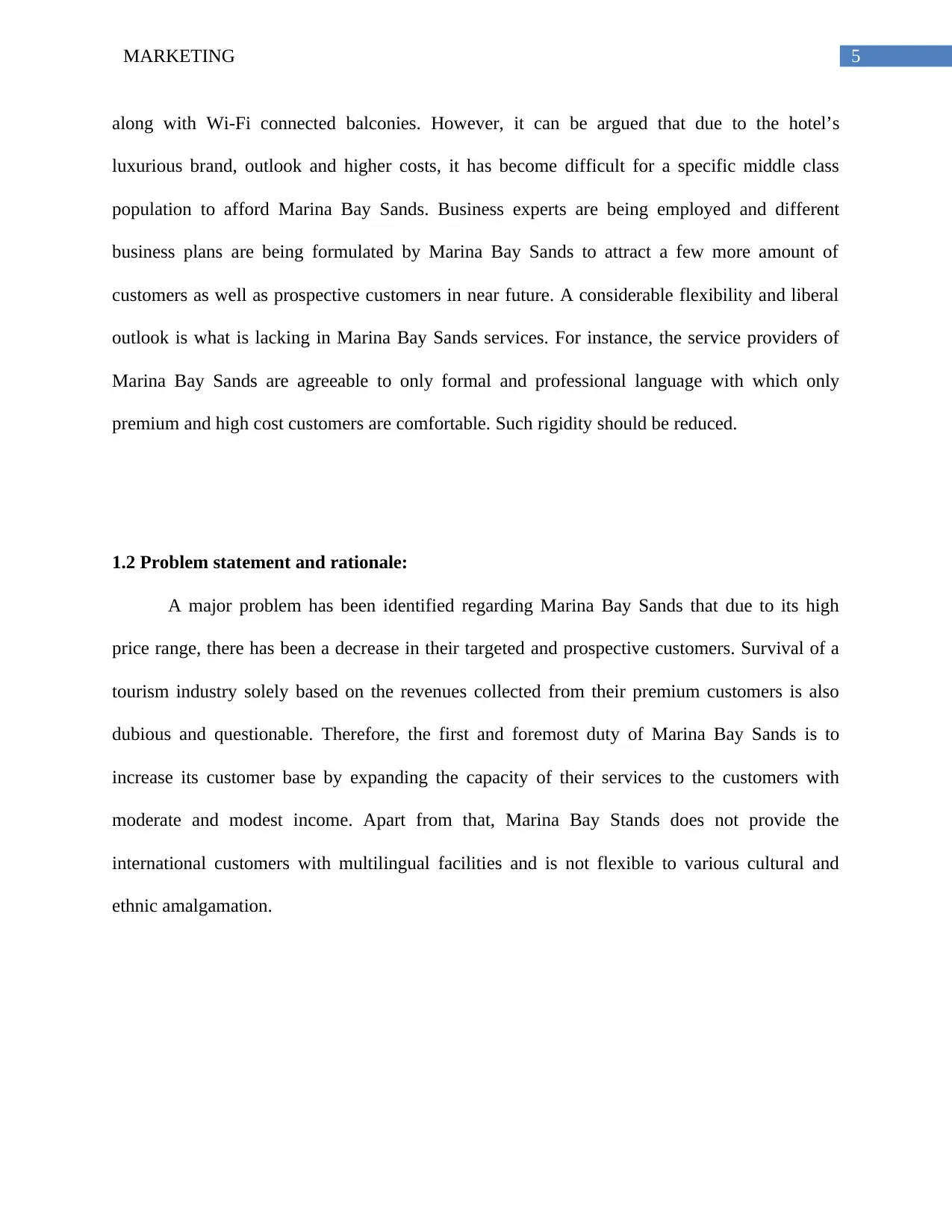
5MARKETING
along with Wi-Fi connected balconies. However, it can be argued that due to the hotel’s
luxurious brand, outlook and higher costs, it has become difficult for a specific middle class
population to afford Marina Bay Sands. Business experts are being employed and different
business plans are being formulated by Marina Bay Sands to attract a few more amount of
customers as well as prospective customers in near future. A considerable flexibility and liberal
outlook is what is lacking in Marina Bay Sands services. For instance, the service providers of
Marina Bay Sands are agreeable to only formal and professional language with which only
premium and high cost customers are comfortable. Such rigidity should be reduced.
1.2 Problem statement and rationale:
A major problem has been identified regarding Marina Bay Sands that due to its high
price range, there has been a decrease in their targeted and prospective customers. Survival of a
tourism industry solely based on the revenues collected from their premium customers is also
dubious and questionable. Therefore, the first and foremost duty of Marina Bay Sands is to
increase its customer base by expanding the capacity of their services to the customers with
moderate and modest income. Apart from that, Marina Bay Stands does not provide the
international customers with multilingual facilities and is not flexible to various cultural and
ethnic amalgamation.
along with Wi-Fi connected balconies. However, it can be argued that due to the hotel’s
luxurious brand, outlook and higher costs, it has become difficult for a specific middle class
population to afford Marina Bay Sands. Business experts are being employed and different
business plans are being formulated by Marina Bay Sands to attract a few more amount of
customers as well as prospective customers in near future. A considerable flexibility and liberal
outlook is what is lacking in Marina Bay Sands services. For instance, the service providers of
Marina Bay Sands are agreeable to only formal and professional language with which only
premium and high cost customers are comfortable. Such rigidity should be reduced.
1.2 Problem statement and rationale:
A major problem has been identified regarding Marina Bay Sands that due to its high
price range, there has been a decrease in their targeted and prospective customers. Survival of a
tourism industry solely based on the revenues collected from their premium customers is also
dubious and questionable. Therefore, the first and foremost duty of Marina Bay Sands is to
increase its customer base by expanding the capacity of their services to the customers with
moderate and modest income. Apart from that, Marina Bay Stands does not provide the
international customers with multilingual facilities and is not flexible to various cultural and
ethnic amalgamation.
⊘ This is a preview!⊘
Do you want full access?
Subscribe today to unlock all pages.

Trusted by 1+ million students worldwide
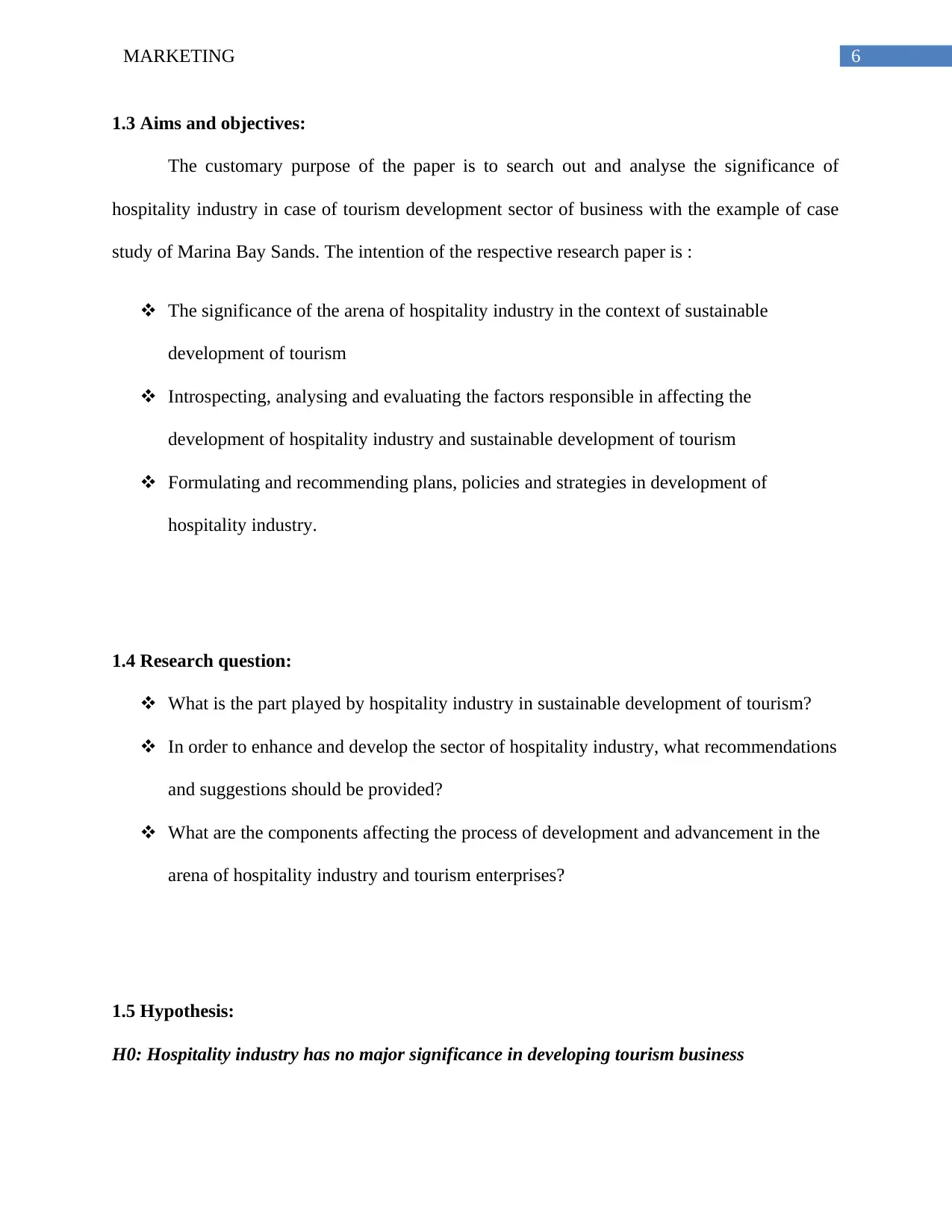
6MARKETING
1.3 Aims and objectives:
The customary purpose of the paper is to search out and analyse the significance of
hospitality industry in case of tourism development sector of business with the example of case
study of Marina Bay Sands. The intention of the respective research paper is :
The significance of the arena of hospitality industry in the context of sustainable
development of tourism
Introspecting, analysing and evaluating the factors responsible in affecting the
development of hospitality industry and sustainable development of tourism
Formulating and recommending plans, policies and strategies in development of
hospitality industry.
1.4 Research question:
What is the part played by hospitality industry in sustainable development of tourism?
In order to enhance and develop the sector of hospitality industry, what recommendations
and suggestions should be provided?
What are the components affecting the process of development and advancement in the
arena of hospitality industry and tourism enterprises?
1.5 Hypothesis:
H0: Hospitality industry has no major significance in developing tourism business
1.3 Aims and objectives:
The customary purpose of the paper is to search out and analyse the significance of
hospitality industry in case of tourism development sector of business with the example of case
study of Marina Bay Sands. The intention of the respective research paper is :
The significance of the arena of hospitality industry in the context of sustainable
development of tourism
Introspecting, analysing and evaluating the factors responsible in affecting the
development of hospitality industry and sustainable development of tourism
Formulating and recommending plans, policies and strategies in development of
hospitality industry.
1.4 Research question:
What is the part played by hospitality industry in sustainable development of tourism?
In order to enhance and develop the sector of hospitality industry, what recommendations
and suggestions should be provided?
What are the components affecting the process of development and advancement in the
arena of hospitality industry and tourism enterprises?
1.5 Hypothesis:
H0: Hospitality industry has no major significance in developing tourism business
Paraphrase This Document
Need a fresh take? Get an instant paraphrase of this document with our AI Paraphraser
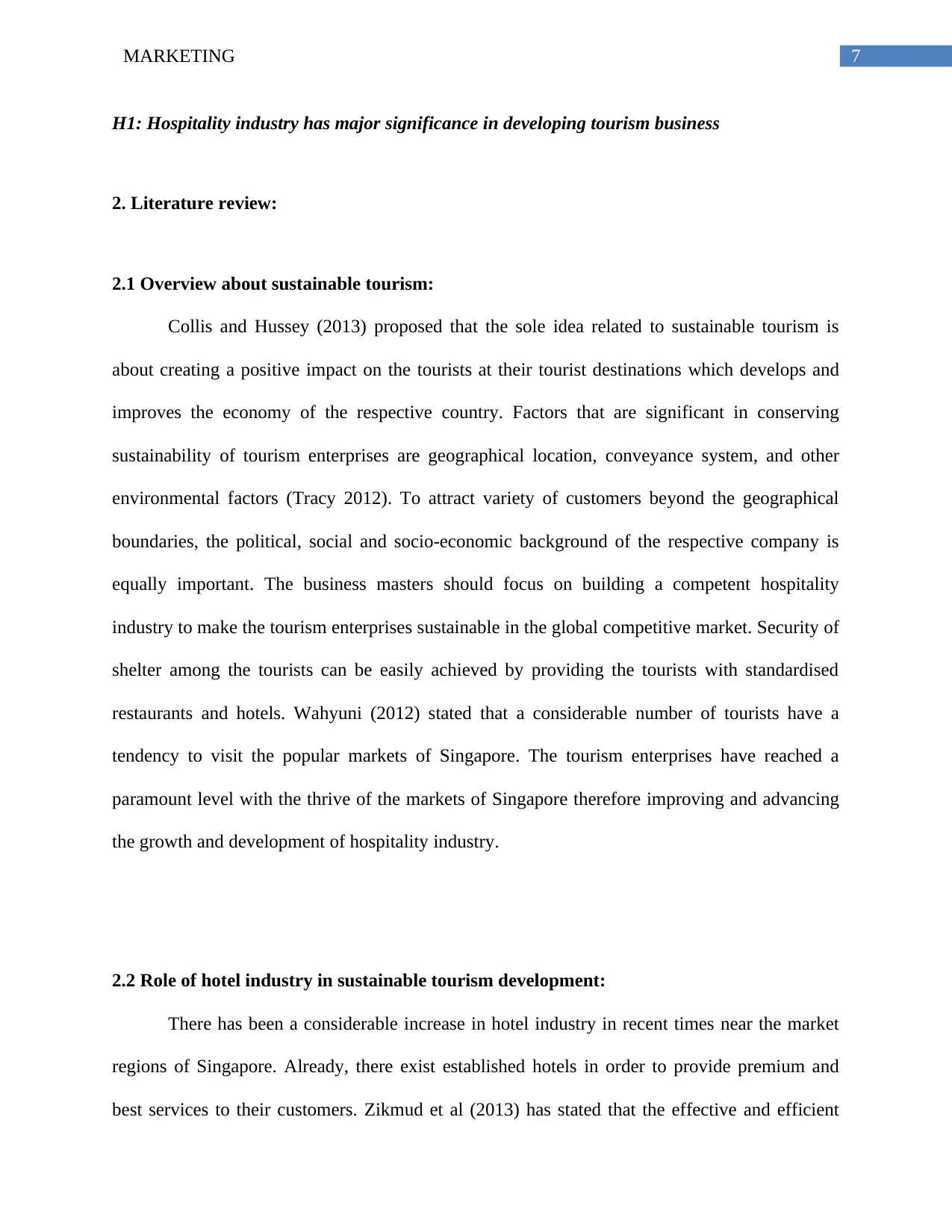
7MARKETING
H1: Hospitality industry has major significance in developing tourism business
2. Literature review:
2.1 Overview about sustainable tourism:
Collis and Hussey (2013) proposed that the sole idea related to sustainable tourism is
about creating a positive impact on the tourists at their tourist destinations which develops and
improves the economy of the respective country. Factors that are significant in conserving
sustainability of tourism enterprises are geographical location, conveyance system, and other
environmental factors (Tracy 2012). To attract variety of customers beyond the geographical
boundaries, the political, social and socio-economic background of the respective company is
equally important. The business masters should focus on building a competent hospitality
industry to make the tourism enterprises sustainable in the global competitive market. Security of
shelter among the tourists can be easily achieved by providing the tourists with standardised
restaurants and hotels. Wahyuni (2012) stated that a considerable number of tourists have a
tendency to visit the popular markets of Singapore. The tourism enterprises have reached a
paramount level with the thrive of the markets of Singapore therefore improving and advancing
the growth and development of hospitality industry.
2.2 Role of hotel industry in sustainable tourism development:
There has been a considerable increase in hotel industry in recent times near the market
regions of Singapore. Already, there exist established hotels in order to provide premium and
best services to their customers. Zikmud et al (2013) has stated that the effective and efficient
H1: Hospitality industry has major significance in developing tourism business
2. Literature review:
2.1 Overview about sustainable tourism:
Collis and Hussey (2013) proposed that the sole idea related to sustainable tourism is
about creating a positive impact on the tourists at their tourist destinations which develops and
improves the economy of the respective country. Factors that are significant in conserving
sustainability of tourism enterprises are geographical location, conveyance system, and other
environmental factors (Tracy 2012). To attract variety of customers beyond the geographical
boundaries, the political, social and socio-economic background of the respective company is
equally important. The business masters should focus on building a competent hospitality
industry to make the tourism enterprises sustainable in the global competitive market. Security of
shelter among the tourists can be easily achieved by providing the tourists with standardised
restaurants and hotels. Wahyuni (2012) stated that a considerable number of tourists have a
tendency to visit the popular markets of Singapore. The tourism enterprises have reached a
paramount level with the thrive of the markets of Singapore therefore improving and advancing
the growth and development of hospitality industry.
2.2 Role of hotel industry in sustainable tourism development:
There has been a considerable increase in hotel industry in recent times near the market
regions of Singapore. Already, there exist established hotels in order to provide premium and
best services to their customers. Zikmud et al (2013) has stated that the effective and efficient
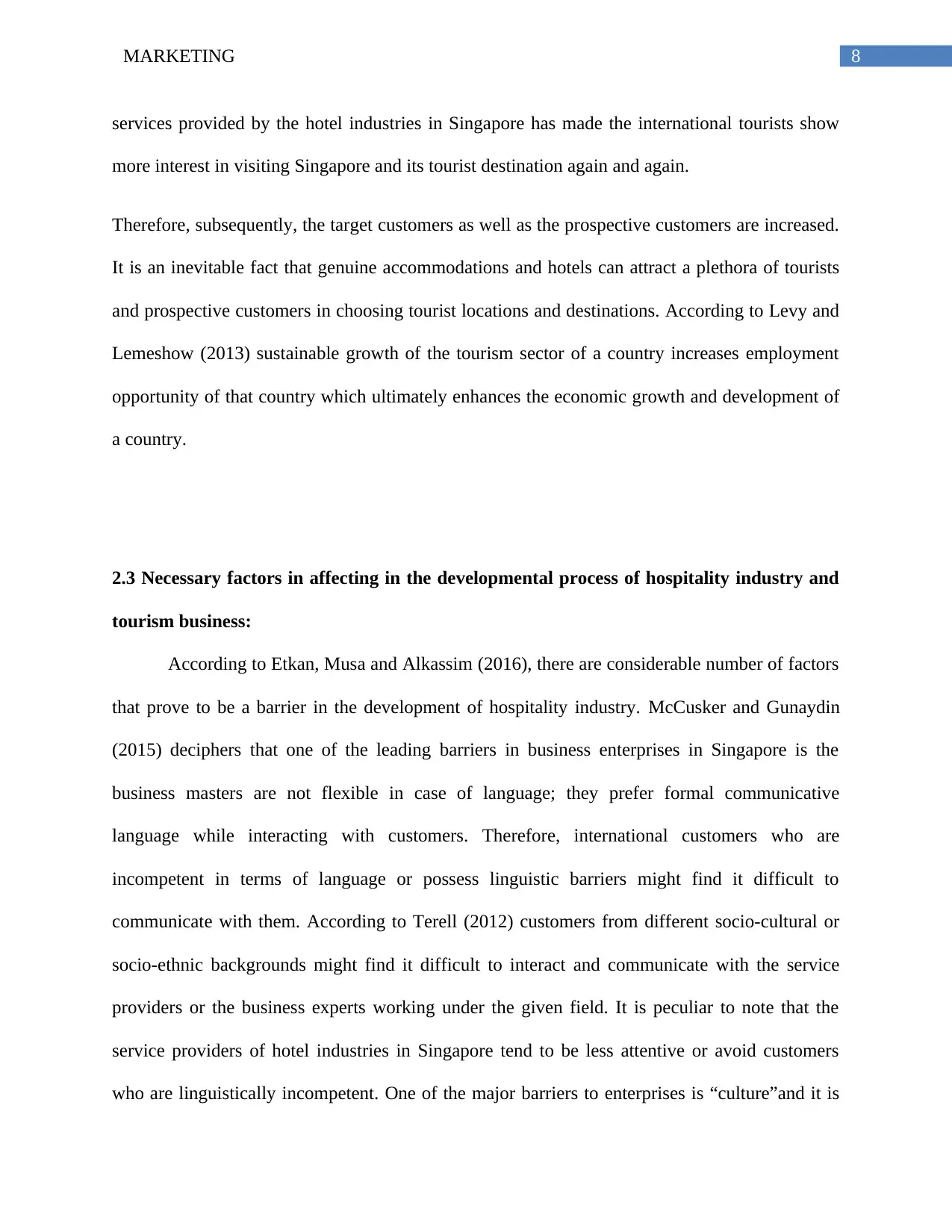
8MARKETING
services provided by the hotel industries in Singapore has made the international tourists show
more interest in visiting Singapore and its tourist destination again and again.
Therefore, subsequently, the target customers as well as the prospective customers are increased.
It is an inevitable fact that genuine accommodations and hotels can attract a plethora of tourists
and prospective customers in choosing tourist locations and destinations. According to Levy and
Lemeshow (2013) sustainable growth of the tourism sector of a country increases employment
opportunity of that country which ultimately enhances the economic growth and development of
a country.
2.3 Necessary factors in affecting in the developmental process of hospitality industry and
tourism business:
According to Etkan, Musa and Alkassim (2016), there are considerable number of factors
that prove to be a barrier in the development of hospitality industry. McCusker and Gunaydin
(2015) deciphers that one of the leading barriers in business enterprises in Singapore is the
business masters are not flexible in case of language; they prefer formal communicative
language while interacting with customers. Therefore, international customers who are
incompetent in terms of language or possess linguistic barriers might find it difficult to
communicate with them. According to Terell (2012) customers from different socio-cultural or
socio-ethnic backgrounds might find it difficult to interact and communicate with the service
providers or the business experts working under the given field. It is peculiar to note that the
service providers of hotel industries in Singapore tend to be less attentive or avoid customers
who are linguistically incompetent. One of the major barriers to enterprises is “culture”and it is
services provided by the hotel industries in Singapore has made the international tourists show
more interest in visiting Singapore and its tourist destination again and again.
Therefore, subsequently, the target customers as well as the prospective customers are increased.
It is an inevitable fact that genuine accommodations and hotels can attract a plethora of tourists
and prospective customers in choosing tourist locations and destinations. According to Levy and
Lemeshow (2013) sustainable growth of the tourism sector of a country increases employment
opportunity of that country which ultimately enhances the economic growth and development of
a country.
2.3 Necessary factors in affecting in the developmental process of hospitality industry and
tourism business:
According to Etkan, Musa and Alkassim (2016), there are considerable number of factors
that prove to be a barrier in the development of hospitality industry. McCusker and Gunaydin
(2015) deciphers that one of the leading barriers in business enterprises in Singapore is the
business masters are not flexible in case of language; they prefer formal communicative
language while interacting with customers. Therefore, international customers who are
incompetent in terms of language or possess linguistic barriers might find it difficult to
communicate with them. According to Terell (2012) customers from different socio-cultural or
socio-ethnic backgrounds might find it difficult to interact and communicate with the service
providers or the business experts working under the given field. It is peculiar to note that the
service providers of hotel industries in Singapore tend to be less attentive or avoid customers
who are linguistically incompetent. One of the major barriers to enterprises is “culture”and it is
⊘ This is a preview!⊘
Do you want full access?
Subscribe today to unlock all pages.

Trusted by 1+ million students worldwide
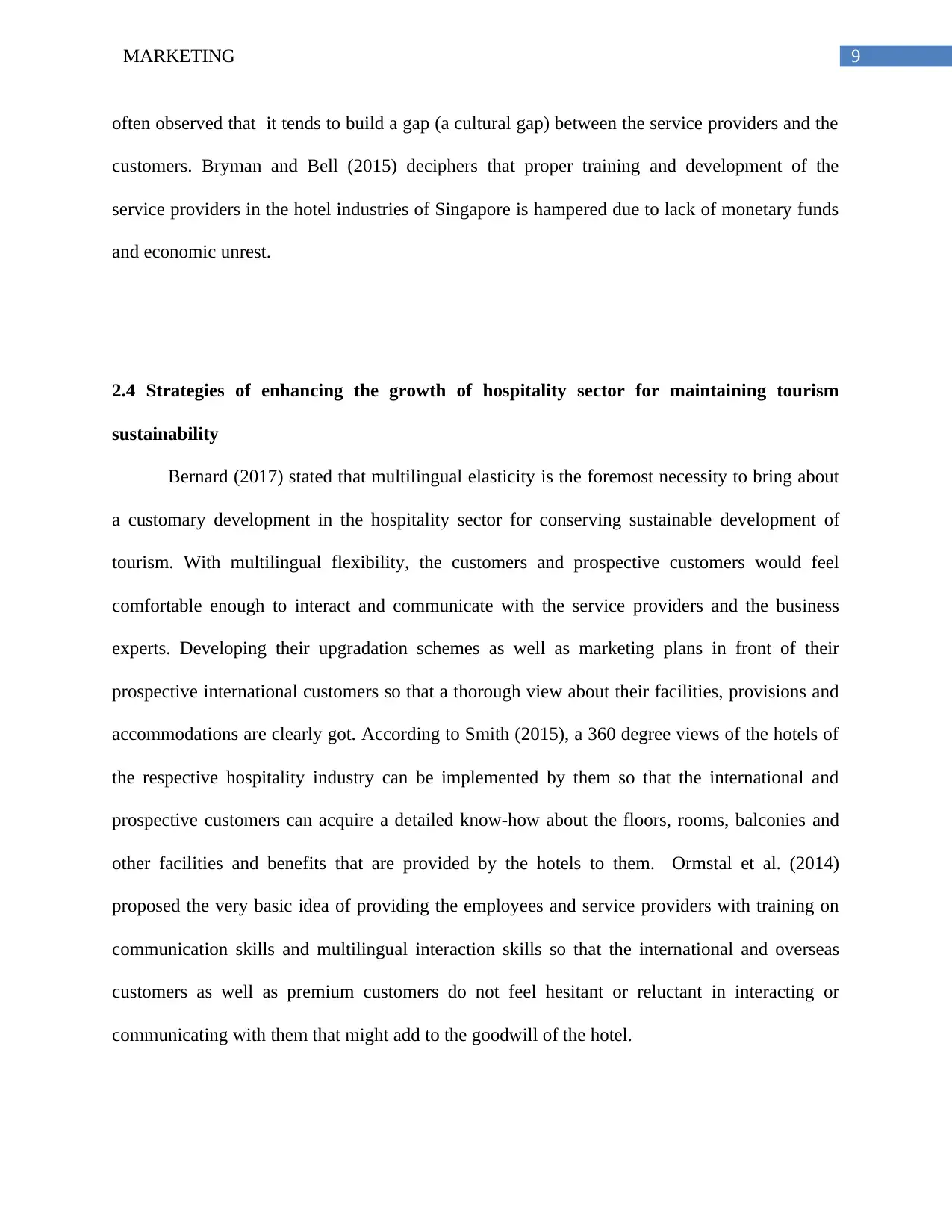
9MARKETING
often observed that it tends to build a gap (a cultural gap) between the service providers and the
customers. Bryman and Bell (2015) deciphers that proper training and development of the
service providers in the hotel industries of Singapore is hampered due to lack of monetary funds
and economic unrest.
2.4 Strategies of enhancing the growth of hospitality sector for maintaining tourism
sustainability
Bernard (2017) stated that multilingual elasticity is the foremost necessity to bring about
a customary development in the hospitality sector for conserving sustainable development of
tourism. With multilingual flexibility, the customers and prospective customers would feel
comfortable enough to interact and communicate with the service providers and the business
experts. Developing their upgradation schemes as well as marketing plans in front of their
prospective international customers so that a thorough view about their facilities, provisions and
accommodations are clearly got. According to Smith (2015), a 360 degree views of the hotels of
the respective hospitality industry can be implemented by them so that the international and
prospective customers can acquire a detailed know-how about the floors, rooms, balconies and
other facilities and benefits that are provided by the hotels to them. Ormstal et al. (2014)
proposed the very basic idea of providing the employees and service providers with training on
communication skills and multilingual interaction skills so that the international and overseas
customers as well as premium customers do not feel hesitant or reluctant in interacting or
communicating with them that might add to the goodwill of the hotel.
often observed that it tends to build a gap (a cultural gap) between the service providers and the
customers. Bryman and Bell (2015) deciphers that proper training and development of the
service providers in the hotel industries of Singapore is hampered due to lack of monetary funds
and economic unrest.
2.4 Strategies of enhancing the growth of hospitality sector for maintaining tourism
sustainability
Bernard (2017) stated that multilingual elasticity is the foremost necessity to bring about
a customary development in the hospitality sector for conserving sustainable development of
tourism. With multilingual flexibility, the customers and prospective customers would feel
comfortable enough to interact and communicate with the service providers and the business
experts. Developing their upgradation schemes as well as marketing plans in front of their
prospective international customers so that a thorough view about their facilities, provisions and
accommodations are clearly got. According to Smith (2015), a 360 degree views of the hotels of
the respective hospitality industry can be implemented by them so that the international and
prospective customers can acquire a detailed know-how about the floors, rooms, balconies and
other facilities and benefits that are provided by the hotels to them. Ormstal et al. (2014)
proposed the very basic idea of providing the employees and service providers with training on
communication skills and multilingual interaction skills so that the international and overseas
customers as well as premium customers do not feel hesitant or reluctant in interacting or
communicating with them that might add to the goodwill of the hotel.
Paraphrase This Document
Need a fresh take? Get an instant paraphrase of this document with our AI Paraphraser
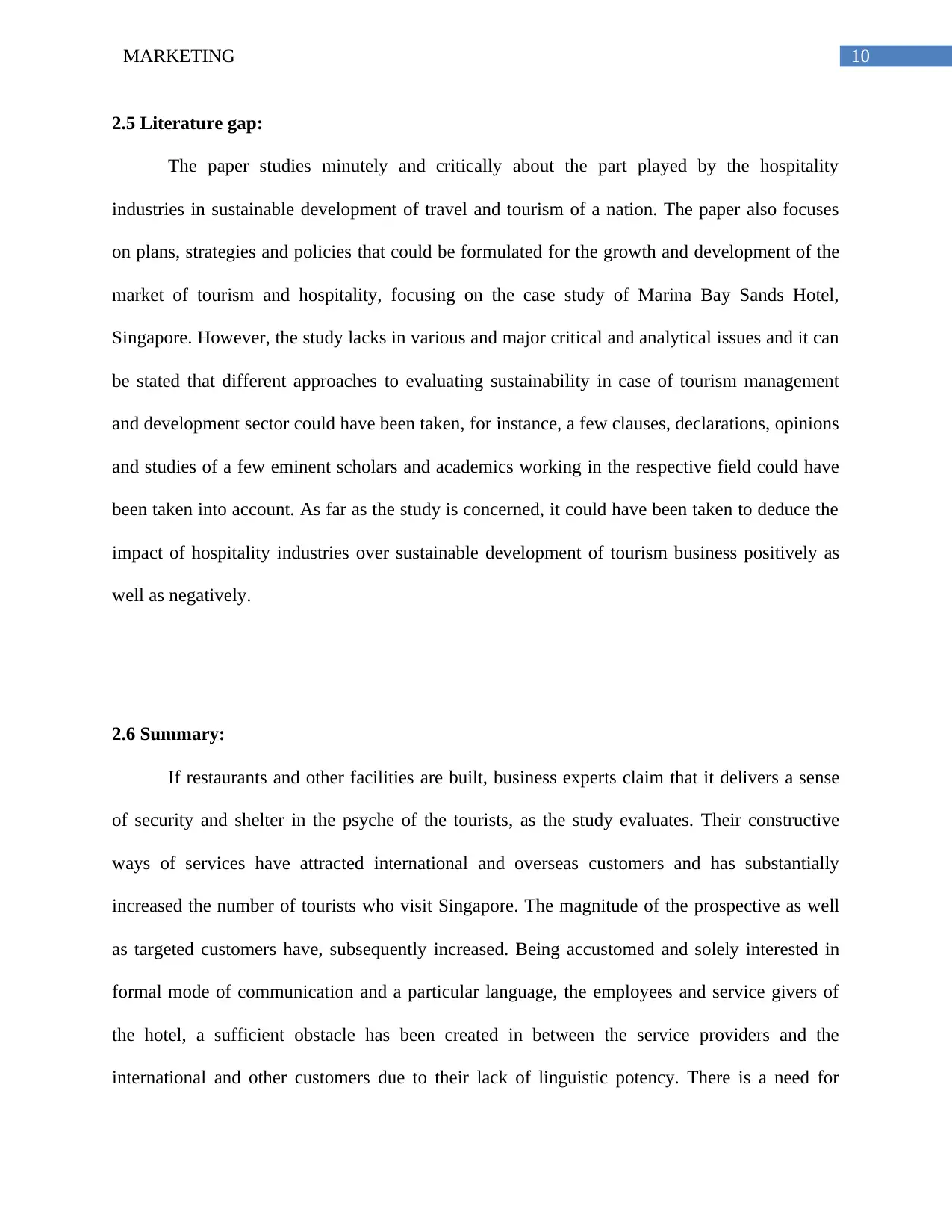
10MARKETING
2.5 Literature gap:
The paper studies minutely and critically about the part played by the hospitality
industries in sustainable development of travel and tourism of a nation. The paper also focuses
on plans, strategies and policies that could be formulated for the growth and development of the
market of tourism and hospitality, focusing on the case study of Marina Bay Sands Hotel,
Singapore. However, the study lacks in various and major critical and analytical issues and it can
be stated that different approaches to evaluating sustainability in case of tourism management
and development sector could have been taken, for instance, a few clauses, declarations, opinions
and studies of a few eminent scholars and academics working in the respective field could have
been taken into account. As far as the study is concerned, it could have been taken to deduce the
impact of hospitality industries over sustainable development of tourism business positively as
well as negatively.
2.6 Summary:
If restaurants and other facilities are built, business experts claim that it delivers a sense
of security and shelter in the psyche of the tourists, as the study evaluates. Their constructive
ways of services have attracted international and overseas customers and has substantially
increased the number of tourists who visit Singapore. The magnitude of the prospective as well
as targeted customers have, subsequently increased. Being accustomed and solely interested in
formal mode of communication and a particular language, the employees and service givers of
the hotel, a sufficient obstacle has been created in between the service providers and the
international and other customers due to their lack of linguistic potency. There is a need for
2.5 Literature gap:
The paper studies minutely and critically about the part played by the hospitality
industries in sustainable development of travel and tourism of a nation. The paper also focuses
on plans, strategies and policies that could be formulated for the growth and development of the
market of tourism and hospitality, focusing on the case study of Marina Bay Sands Hotel,
Singapore. However, the study lacks in various and major critical and analytical issues and it can
be stated that different approaches to evaluating sustainability in case of tourism management
and development sector could have been taken, for instance, a few clauses, declarations, opinions
and studies of a few eminent scholars and academics working in the respective field could have
been taken into account. As far as the study is concerned, it could have been taken to deduce the
impact of hospitality industries over sustainable development of tourism business positively as
well as negatively.
2.6 Summary:
If restaurants and other facilities are built, business experts claim that it delivers a sense
of security and shelter in the psyche of the tourists, as the study evaluates. Their constructive
ways of services have attracted international and overseas customers and has substantially
increased the number of tourists who visit Singapore. The magnitude of the prospective as well
as targeted customers have, subsequently increased. Being accustomed and solely interested in
formal mode of communication and a particular language, the employees and service givers of
the hotel, a sufficient obstacle has been created in between the service providers and the
international and other customers due to their lack of linguistic potency. There is a need for
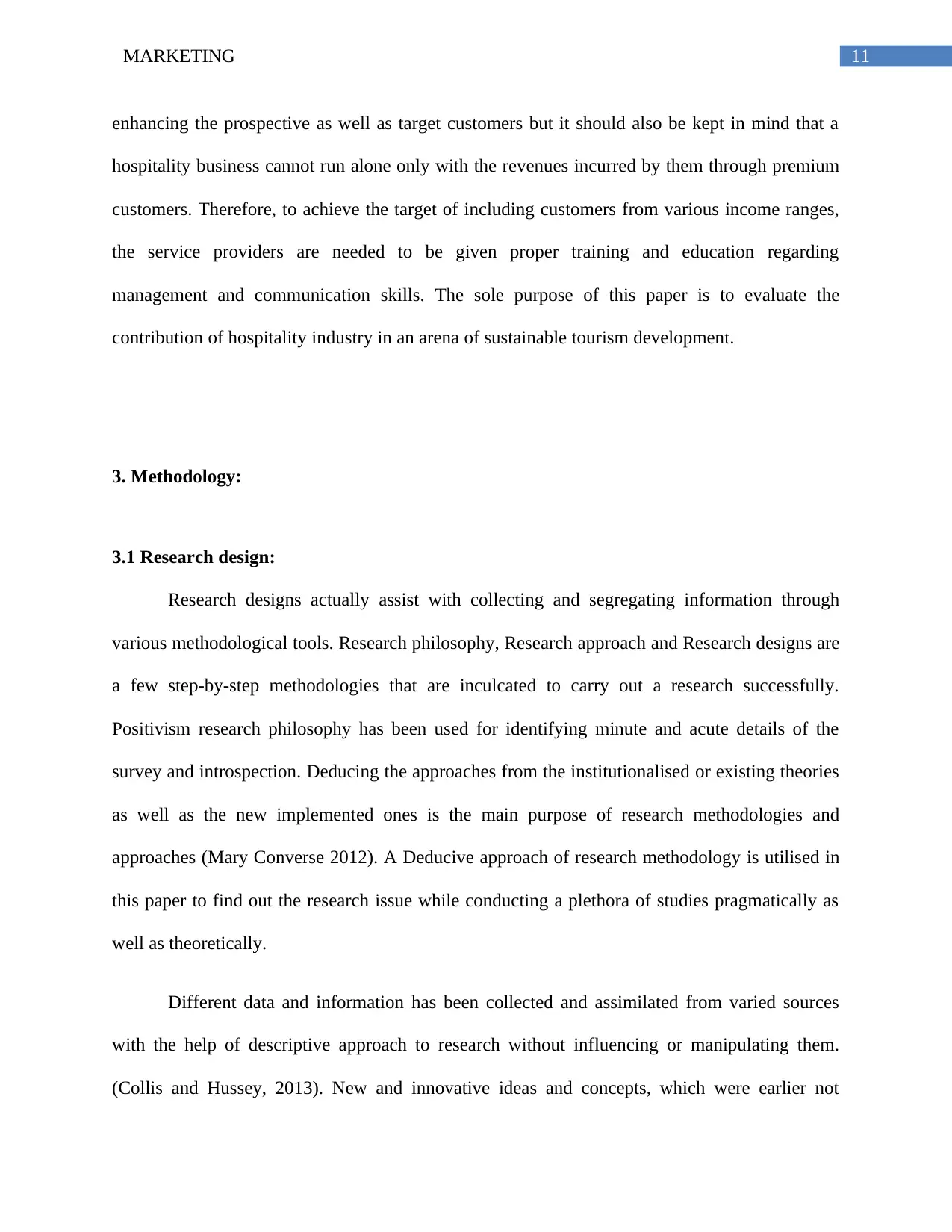
11MARKETING
enhancing the prospective as well as target customers but it should also be kept in mind that a
hospitality business cannot run alone only with the revenues incurred by them through premium
customers. Therefore, to achieve the target of including customers from various income ranges,
the service providers are needed to be given proper training and education regarding
management and communication skills. The sole purpose of this paper is to evaluate the
contribution of hospitality industry in an arena of sustainable tourism development.
3. Methodology:
3.1 Research design:
Research designs actually assist with collecting and segregating information through
various methodological tools. Research philosophy, Research approach and Research designs are
a few step-by-step methodologies that are inculcated to carry out a research successfully.
Positivism research philosophy has been used for identifying minute and acute details of the
survey and introspection. Deducing the approaches from the institutionalised or existing theories
as well as the new implemented ones is the main purpose of research methodologies and
approaches (Mary Converse 2012). A Deducive approach of research methodology is utilised in
this paper to find out the research issue while conducting a plethora of studies pragmatically as
well as theoretically.
Different data and information has been collected and assimilated from varied sources
with the help of descriptive approach to research without influencing or manipulating them.
(Collis and Hussey, 2013). New and innovative ideas and concepts, which were earlier not
enhancing the prospective as well as target customers but it should also be kept in mind that a
hospitality business cannot run alone only with the revenues incurred by them through premium
customers. Therefore, to achieve the target of including customers from various income ranges,
the service providers are needed to be given proper training and education regarding
management and communication skills. The sole purpose of this paper is to evaluate the
contribution of hospitality industry in an arena of sustainable tourism development.
3. Methodology:
3.1 Research design:
Research designs actually assist with collecting and segregating information through
various methodological tools. Research philosophy, Research approach and Research designs are
a few step-by-step methodologies that are inculcated to carry out a research successfully.
Positivism research philosophy has been used for identifying minute and acute details of the
survey and introspection. Deducing the approaches from the institutionalised or existing theories
as well as the new implemented ones is the main purpose of research methodologies and
approaches (Mary Converse 2012). A Deducive approach of research methodology is utilised in
this paper to find out the research issue while conducting a plethora of studies pragmatically as
well as theoretically.
Different data and information has been collected and assimilated from varied sources
with the help of descriptive approach to research without influencing or manipulating them.
(Collis and Hussey, 2013). New and innovative ideas and concepts, which were earlier not
⊘ This is a preview!⊘
Do you want full access?
Subscribe today to unlock all pages.

Trusted by 1+ million students worldwide
1 out of 32
Related Documents
Your All-in-One AI-Powered Toolkit for Academic Success.
+13062052269
info@desklib.com
Available 24*7 on WhatsApp / Email
![[object Object]](/_next/static/media/star-bottom.7253800d.svg)
Unlock your academic potential
Copyright © 2020–2025 A2Z Services. All Rights Reserved. Developed and managed by ZUCOL.





